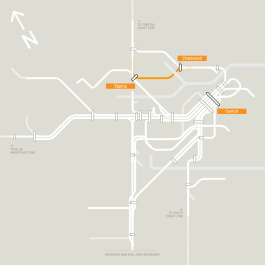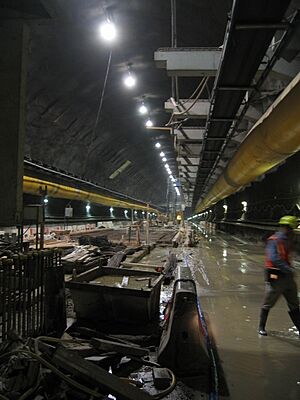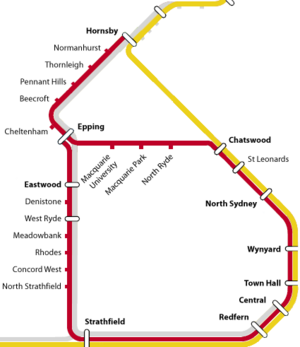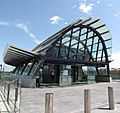Epping to Chatswood rail link facts for kids
Quick facts for kids Epping to Chatswood rail link |
|
|---|---|

Sydney Metropolitan Rail Area with ECRL highlighted in orange
|
|
| Overview | |
| Status | Converted to Metro North West Line |
| Owner | RailCorp |
| Locale | Sydney, New South Wales, Australia |
| Termini | Chatswood Epping |
| Stations | 5 |
| Service | |
| Operator(s) | Sydney Trains |
| Rolling stock | A sets, H sets |
| History | |
| Opened | 23 February 2009 |
| Closed | 29 September 2018 (converted to Metro North West Line) |
| Technical | |
| Line length | 13 km (8.1 mi) |
| Track gauge | 1,435 mm (4 ft 8 1⁄2 in) |
| Electrification | Overhead 1500 V DC |
The Epping to Chatswood rail link (ECRL) was a train line in the northern suburbs of Sydney, Australia. It connected Epping station with Chatswood. This line was once its own railway line. Today, it is part of the Metro North West Line.
The ECRL was 13 kilometers (about 8 miles) long. It ran completely underground. The line had three stations: Macquarie University, Macquarie Park, and North Ryde. The main stations at Epping and Chatswood were also updated for the new line.
The ECRL was a suburban train line for less than ten years. It opened in February 2009 and closed in September 2018. This closure was for a big change. Most of the line's structures were used for the new Metro North West Line. This change was part of the Sydney Metro Northwest project.
Contents
Early Train Line Ideas
People have thought about building a train line between Sydney's North Shore and the Main Northern lines for a long time. The first ideas came in September 1920. An engineer named John Bradfield suggested a railway between St Leonards and Eastwood.
Later, in the 1930s, the plan changed. The line was then meant to go to Epping. It became known as the "Epping-St Leonards Railway." The government even bought some land in Epping for the train tracks.
In 1929, real estate agents tried to sell land near the planned railway in Epping. They called the area "Epping Junction." This was because the station would connect the new line with the Main Northern Line. A new platform was also built at Epping for the new line.
However, the Great Depression hit, and the project was stopped. It was too expensive to build. Instead, a road was built between St Leonards and Epping, which is now Epping Road. The land sales failed, and the lots near the railway were not sold until much later.
The idea for the line came back in the 1990s. In 1998, the Parramatta Rail Link was announced. This plan was to connect Chatswood, Epping, and Parramatta. Construction was supposed to start in 1999 and finish by 2006.
Building the ECRL
Building the ECRL began in November 2002. This first part was the section from Chatswood to Epping.
In August 2003, the government decided to delay the Epping to Parramatta section. They felt it would not have enough passengers to be worth the $1.2 billion cost. There were also protests about the line going through Parramatta Park.
At first, there was a plan for a bridge over the Lane Cove River. But the government chose to build a tunnel instead. This was because of concerns from local communities and environmental groups. Building a deeper tunnel meant they had to remove a planned station at the University of Technology, Sydney, Kuring-gai Campus. The tunnel was too deep there for a station.
The company Thiess and Hochtief worked together to build the project. They designed and built the railway and four underground stations. The line has two tunnels, one for each track. Large tunnel boring machines were used to dig the tunnels. A part under the Lane Cove River was built using a "cut and cover" method. The tunnels have walkways on one side for safety.
Other important works were also finished for the new line. These included a rebuilt Chatswood interchange and a big upgrade at Epping station.
Challenges During Construction
In December 2007, it was announced that certain trains, called Tangara trains, would not run on the line. This was because the tunnel was too steep for them. The line owner, RailCorp, said it was not a mistake. They said Tangara trains were "not ideally suited" to the steep slopes.
In February 2008, it was found that noise-reducing mats in the tunnels had come loose. At least half of the 14 kilometers of track needed to be re-laid. In October 2008, tests showed that train noise levels were very high, around 90 decibels. This is as loud as a 737 plane landing. Fixing these issues added to the cost, which grew from $1.4 billion to $2.3 billion.
In July 2009, train drivers reported problems. They were limited to two return trips through the tunnel before taking a break. They also had to keep cabin lights on and lower window blinds. This was to avoid a possible stroboscopic effect from the tunnel lights. Drivers said it caused headaches, dizziness, and tiredness.
First Train Services
The ECRL opened on February 23, 2009. It started as a shuttle service between Epping and Chatswood. The opening was moved from February 22 due to a national day of mourning. This was for victims of the Black Saturday bushfires in Victoria.
The line was free to use until June 8, 2009. Passengers could use a special pass or buy a ticket. Later, the automatic gates at the new stations were turned on. Passengers then needed to buy a ticket as usual.
OSCARS (Outer Suburban Cars) trains were used for the shuttle service. These were the newest trains at the time. They were used because of the tunnel's steepness and noise. Trains ran every 15 minutes. The shuttle service ended on October 11, 2009.
Joining the Main Network
After the shuttle service, the ECRL became part of the Northern Line. Most Northern Line trains from Hornsby to Epping used the new link. They then continued along the North Shore Line to the city. From there, they returned to Epping via Strathfield.
Trains reversed direction at Epping's above-ground platforms. They then followed the opposite route back to Hornsby. K sets and some OSCARS trains were used for these services. On weekdays, four trains per hour ran between Hornsby and the City using the ECRL.
On October 20, 2013, the Northern Line changed its name. It became the North Shore, Northern & Western Line. On weekdays, trains from Hornsby went to Richmond or Emu Plains via the ECRL. On weekends, the Hornsby to Epping loop continued.
The ECRL was also used by trains on the Central Coast & Newcastle Line. This happened if the main line between Strathfield and Epping had problems.
Becoming Sydney Metro
In February 2010, the New South Wales Government announced the North West Rail Link again. This new line would connect with the ECRL at Epping.
On August 11, 2010, Prime Minister Julia Gillard announced funding for the Epping to Parramatta Rail Link. This was a plan from 1998 that had been stopped. Work was expected to start in 2011 and finish by 2017. However, this plan was later abandoned.
The new government continued planning for the North West Rail Link. In 2012, they announced that the project would use different technology. It would have single-deck, automated trains with platform screen doors. This project was renamed Sydney Metro Northwest. It included changing the Epping to Chatswood section. This change would make it part of the new Sydney Metro network.
The ECRL closed on September 29, 2018, for this conversion. The change took eight months. During this time, temporary bus services helped passengers. The Metro North West Line, including the five former ECRL stations, opened on May 26, 2019. The old Northern line route from Hornsby to Central via Strathfield was brought back. North Shore services that used the ECRL now went beyond Chatswood towards Gordon, Hornsby, or Berowra.
Images for kids








